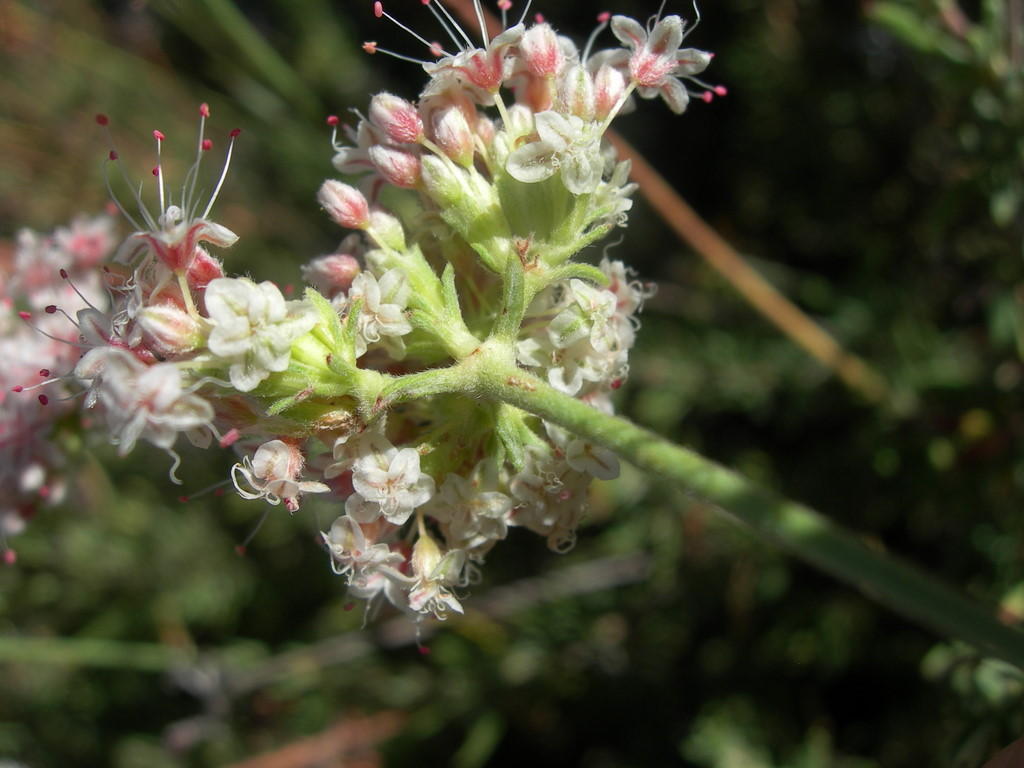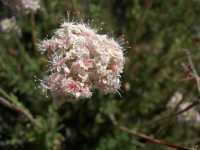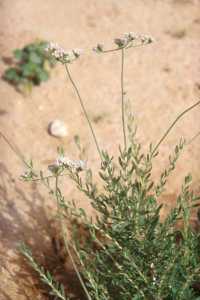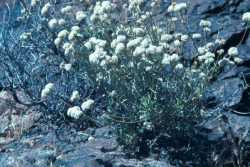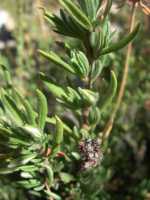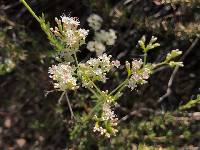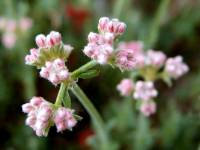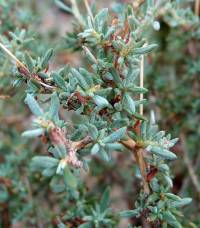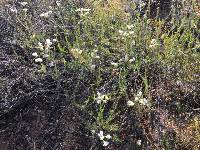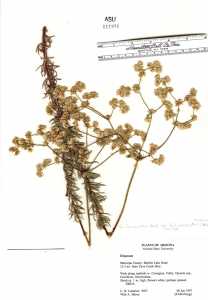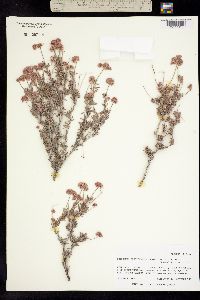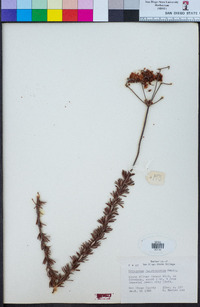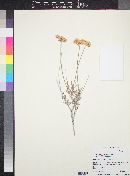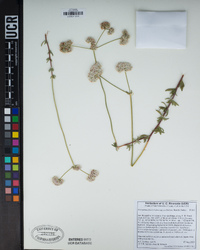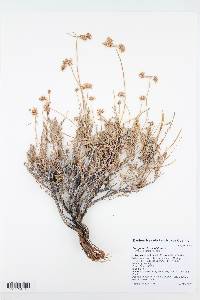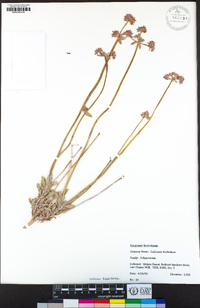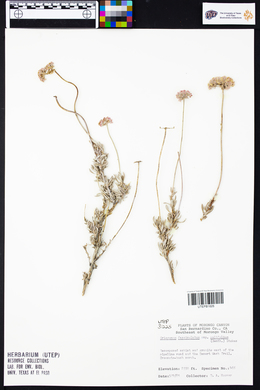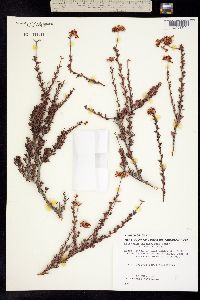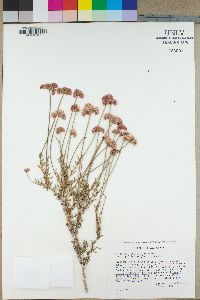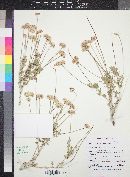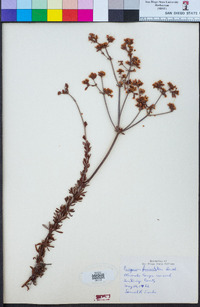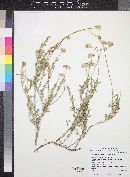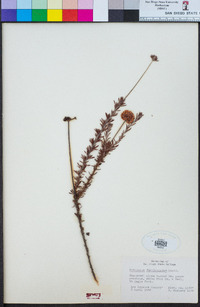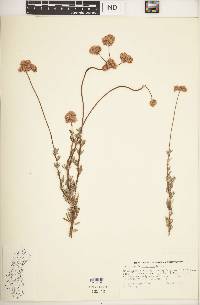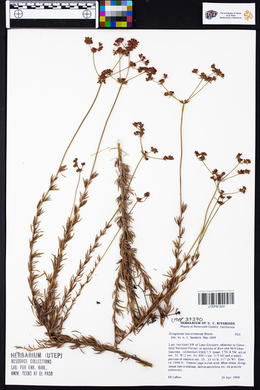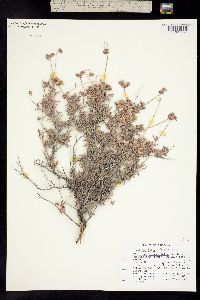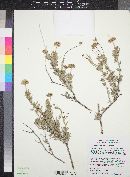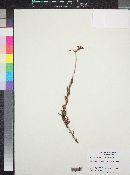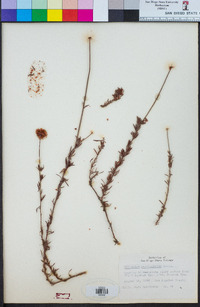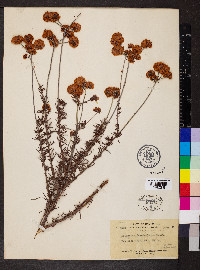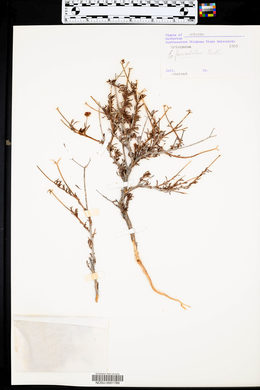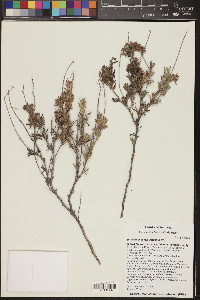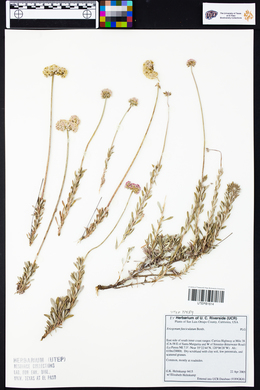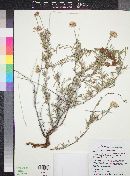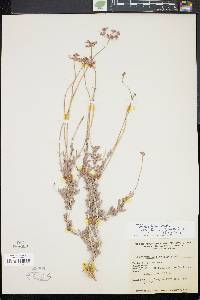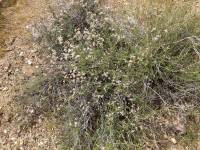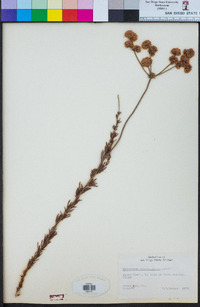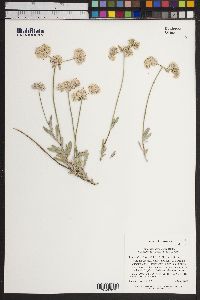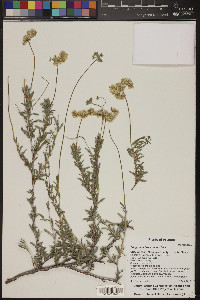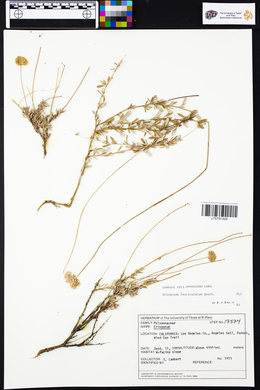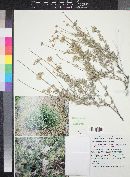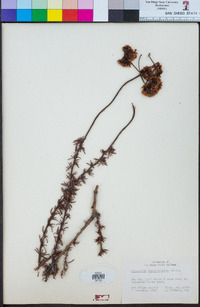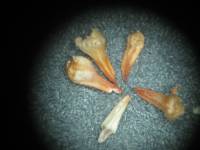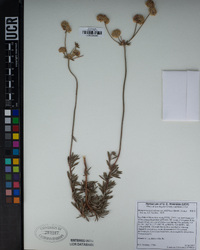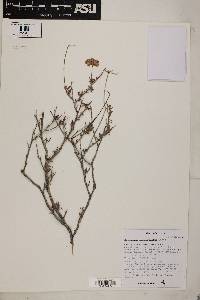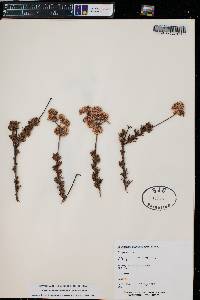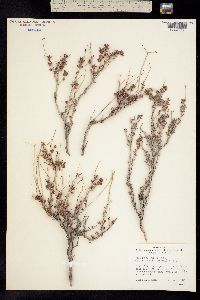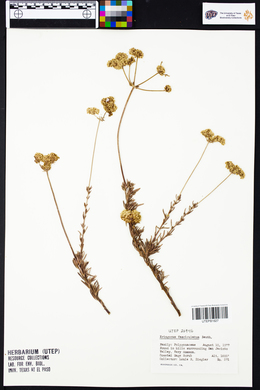Eriogonum fasciculatum
|
|
|
|
Family: Polygonaceae
Eastern Mojave buckwheat, more...Eastern Mojave Wild Buckwheat, flat-top buckwheat, California buckwheat, Mojave buckwheat, flattop buckwheat, yellow buckwheat (es: maderista, gordo lobo)
[Eriogonum fasciculatum subsp. aspalathoides (Gand.) S. Stokes, moreEriogonum fasciculatum subsp. fasciculatum] |
Shrubs or subshrubs, compact to spreading or rounded and more or less erect, occasionally decumbent, infrequently scapose, (1-)2-15 × 2-25(-30) dm, tomentose to canescent, floccose, or glabrous. Stems sprawling or spreading to erect, often with persistent leaf bases, up to 1/ 2 or more height of plant; caudex stems absent or matted to spreading; aerial flowering stems erect to spreading, slender, solid, not fistulose, 0.3-2.5(-3) dm, tomentose, canescent, or glabrous. Leaves cauline, 1 per node or fasciculate; petiole 0.1-0.3 cm, canescent; blade linear to linear-oblanceolate or oblanceolate, 0.6-1.5(-1.8) × 0.05-0.4(-0.6) cm, white-tomentose or canescent to subglabrous abaxially, tomentose or canescent and grayish, subglabrous, or glabrous and green adaxially, margins often revolute. Inflorescences cymose, infrequently cymose-umbellate or capitate, compact to open, occasionally flat-topped, 0.2-20 × 0.2-15 cm; branches dichotomous, infrequently absent, tomentose to canescent or glabrous; bracts usually 3, scalelike, triangular, and 1-3 mm, or leaflike, linear to oblanceolate, and 3-10 × 1-3 mm. Peduncles absent. Involucres (1-)3-8 per cluster, turbinate to campanulate, 2-4 × 1.5-3 mm, canescent, pubescent, glabrous, or subglabrous; teeth 5, erect, 0.3-1.2 mm. Flowers 2.5-3 mm; perianth white to pinkish, glabrous or pubescent; tepals connate proximal 1/ 4, monomorphic, usually elliptic to obovate; stamens exserted, 2.5-5 mm; filaments subglabrous or pubescent proximally. Achenes light brown to brown, 1.8-2.5 mm, glabrous. Eriogonum fasciculatum is a complex, polyploid series of variants that are generally distinct but often difficult to distinguish morphologically. Variety emphereium Reveal is confined to central Baja California, Mexico. The introduction of Eriogonum fasciculatum as a decorative roadside plant by the California Department of Transportation is resulting in hybrid populations involving E. cinereum. The aggressively weedy and (for Arizona) exotic variety foliosum is rapidly invading the native habitat of var. polifolium. Members of E. fasciculatum are food plants for several butterflies, notably the Bernardino dotted-blue (Euphilotes bernardino), lupine blue (Plebeius lupini), Mormon metalmark (Apodemia mormo), and Behr's metalmark (A. virgulti). Probably the butterfly most commonly seen with the species is the nut-brown hairstreak (Satyrium saepium), which frequents plants in full flower. Eriogonum fasciculatum is also the most important native source of honey in California. This widespread species was used extensively by Native Americans for a variety of ailments. Its application for pain and headaches (D. P. Barrows 1900; K. Hedges 1986; E. W. Voegelin 1938) was rather common, as was its general use for diarrhea (Hedges; Voegelin). M. L. Zigmond (1981) reported that the Kawaiisu lined their acorn granaries with leaves of var. proliferum to keep out rain-a daunting challenge given the size of the leaves! L. Hinton (1975) reported the use of a decoction of dried flowers and roots to maintain a healthy heart, and M. C. Stevenson (1915) indicated that a powder derived from the roots was used by the Zuñi to treat wounds, whereas a root decoction was taken for colds and hoarseness. B. R. Bocek (1984) reported that the Costanoan Indians of California used a decoction of the plant to treat unspecified urinary problems. F. H. Elmore (1943) reported the use of a decoction of var. proliferum by the Navajo (Diné) people as an anti-witchcraft medicine.
Wiggins 1964, Benson and Darrow 1981, Kearney and Peebles 1969 Common Name: Eastern Mojave buckwheat Duration: Perennial Nativity: Native Lifeform: Subshrub General: Low spreading woody shrub, 0.5-1 m, compact and much branched with leafy stems and shredding bark; stems, leaves and scapes canescent-pubescent. Leaves: Fascicled, sessile or nearly so, 3-15 mm, white hairy on both surfaces, canescent above, densely woolly below. Flowers: Involucres 5-toothed, 2.5 mm, densely to moderately white hairy; flowers white to pink, 3 mm, outer perianth segments densely white hairy toward base and along broad midrib. Fruits: Achenes 2-2.5 mm. Ecology: Found on dry rocky slopes from 1,000-4,500 ft (305-1372 m); flowers March-June. Notes: The most common shrubby Eriogonum in the region. Several varieties exist in the region, take a collection if identity to this level is required. Otherwise, the woolly bases are key, and it is told apart from the similar E. wrightii by the mostly woody habit, as well as having leaves in dense fascicles of leaves along the stems. Ethnobotany: Used for diarrhea, as an emetic, against witchcraft, for heart medicine, to help heal wounds, for hoarseness, for stomachaches and the wood was used to pierce ears. Etymology: Eriogonum is from Greek erion, wool and phyllon, leaf, fasciculatum is derived from Latin word for bundles. Synonyms: Eriogonum fasciculatum subsp. polifolium, E. fasciculatum var. revolutum, E. poliofolium Editor: SBuckley, 2010 |
|
|
|

